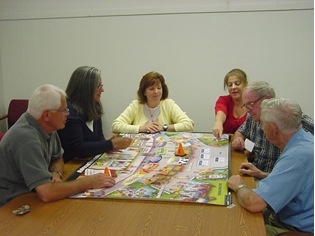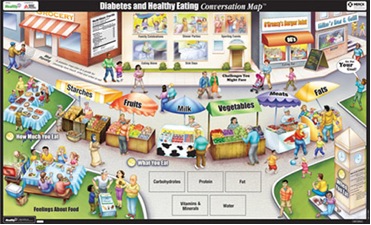 |
February 2010
|
February 2010 // Volume 48 // Number 1 // Ideas at Work // v48-1iw5
Applying New Diabetes Teaching Tools in Health-Related Extension Programming
Abstract
In response to the emerging global diabetes epidemic, health educators are searching for new and better education tools to help people make positive behavior changes to successfully prevent or manage diabetes. Conversation Maps® are new learner-driven education tools that have been developed to empower individuals to improve their health outcomes. While the tools were originally developed for clinical settings, this article describes a model Extension health outreach program that uses Conversation Map techniques to teach diabetes awareness and healthy eating in community group settings. These techniques can be used as a model for teaching other health topics to adult learners.
Introduction
Diabetes is increasing in prevalence in the United States and worldwide. In particular, type 2 diabetes has reached epidemic proportions, paralleling increases in overweight and obesity observed over the last several decades (Centers for Disease Control and Prevention, 2007). While there is no cure for diabetes, studies show that moderate weight loss through healthy eating and physical activity can prevent progression of pre-diabetes (abnormally elevated blood glucose) to type 2 diabetes (Knowler et al., 2002). For individuals already diagnosed with diabetes, aggressive blood glucose control (through lifestyle factors and medication therapy) can prevent or delay diabetes-related complications (Diabetes Control and Complications Trial Research Group, 1993). Despite this evidence, many people struggle to make the behavior changes important for improved health and to sustain these changes for the long-term.
Education on self-management of diabetes is associated with improved blood glucose control (Norris, Lau, Smith, Schmid, & Engelgau, 2002). This education is typically delivered in clinical settings, such as hospitals or outpatient clinics, and may not be accessible by all individuals who need it, due to high cost and lack of insurance reimbursement, the logistics of attending sessions, and other factors (Peyrot, 2007). Health educators have begun to recognize the need for new strategies for diabetes education. Group consultations, support groups, and community education classes are potential new venues for supplementing and reinforcing traditional health education (Tang, Funnell, & Anderson, 2006; Trento et al., 2001).
Extension educators, through their unique positioning in local communities, can potentially extend diabetes education to diverse and underserved audiences. Recent Extension program outreach has included topics in healthy meal planning (Chapman-Novakofski et al., 2004; Raidl et al., 2007; Williams, LeBlanc, & Christensen, 2004) and the prevention of diabetes in at- risk individuals (Corbin, Kiernan, & Getting, 2007). This article describes a new group diabetes education tool, and its application in Extension health programming.
New Tools in Diabetes Education to Better Engage Adult Learners
Diabetes Conversation Maps® are tools developed as part of a new educational initiative in the diabetes industry, the Journey for Control™ program (Merck and Co., Inc., 2009). Created by a partnership of healthcare experts (Healthy Interactions, Inc., the American Diabetes Association, and Merck and Co., Inc.), Diabetes Conversation Maps are designed to better engage people in discussions about healthcare topics, such as diabetes self care, healthy eating, and physical activity, and to help them formulate strategies for behavior change.
Conversation Maps are visual tools designed to be used in small, interactive group sessions, where participants learn about key topics in diabetes. The key components of these sessions are summarized in Table 1.
| Session Component | Description |
| The Diabetes Conversation Maps: | A set of five 3ft. x 5ft. colorful, table-top
visual tools which serve as focal points during the session. Example: Individual map topics include basic facts about diabetes, healthy eating, self-monitoring of blood glucose, diabetes complications, and gestational diabetes |
| Question and Discussion Cards | Read by the facilitator to prompt participant
discussion and interaction throughout the session.
Example: Prior knowledge and attitudes about diabetes are explored through "Myth" vs. "Fact" cards. |
| The Facilitator | A trained educator who guides the group discussion to engage participants and promote interactive learning |
| The Participants | Small groups of 3 to 10 individuals who are interested in learning about diabetes |
| Other resources | Hard copy training manual, education tools, electronic newsletter, and web-based resources. |
Applying Diabetes Maps in a Community Education Setting
There is an increasing need for diabetes education in the community setting. Community health education can reinforce education obtained in clinical settings, be tailored to the needs of particular audiences, and accommodate individuals who otherwise would not have access to traditional education, such as people "at risk" of developing diabetes.
After the free training sponsored by the map developers in October, 2007, the first series of Diabetes Conversation Map classes was offered by Rutgers Cooperative Extension, Department of Family and Community Health Sciences (FCHS). The FCHS educator, a Registered Dietitian and Certified Diabetes Educator, facilitated a total of 10, 1.5-hour sessions between November, 2007 and April, 2008. Topics included an overview of diabetes (causes, diagnosis, treatment), and healthy eating for diabetes (effect of foods on blood glucose, healthy meal planning). Participants included consumers and professional groups. Figures 1 and 2 illustrate components of the training sessions.
Figure 1.
A Conversation Map Session Being
Conducted by the FCHS Educator

Figure 2.
Healthy Eating Conversation Map
(picture courtesy of Healthy Interactions, Inc.)

Results and Outcomes
Eighty individuals participated in the Conversation Map training sessions from November, 2007 through April, 2008. Participants included those diagnosed with diabetes or pre-diabetes, family members, individuals "at risk" based on family history, and social services personnel serving clients with diabetes. Participants were surveyed immediately at class completion (91% return rate) with the following results.
- 97% rated the overall sessions "valuable" or "very valuable."
- 98% reported that they felt better able to discuss their diabetes management with their physician.
Twenty individuals who had participated in a two-class map session were surveyed about the format of the conversation map sessions.
- 96% rated the format as an "effective" or "very effective" way to learn about diabetes.
- 84% rated the format as "better" or "much better" than other ways of learning about diabetes, such as in classroom lectures, books, or the Internet.
Participants were surveyed by mail several months after program completion to determine how they were using program information (22% return rate), with the following results.
- 94% reported they were using the
information learned at the training sessions. The most frequently
reported skills or behaviors included:
- Budgeting carbohydrate foods better at meals and snacks
- Controlling food portions
- Reading food labels for carbohydrate and fat content
- Discussing health issues with their physician, pharmacist, or other healthcare provider.
As a result of the program, participants indicated the following improvements in health and well-being:
- Better able to support diabetes care in themselves or others
- Better able to discuss health information with physician
- Feeling in better control of their health and diabetes.
Conclusion
Diabetes Conversation Maps are new tools to engage adult learners in making behavior changes needed for better health. Compared to traditional education methods, Conversation Map sessions focus on participant-directed discussions and shared problem-solving in diabetes self-care topics, such as trouble-shooting of blood glucose levels and maintaining motivation for healthy eating and physical activity. In the community setting, Conversation Map tools can be adapted to cover broader topics related to disease prevention and healthy lifestyles. Extension educators can partner with other skilled health educators, such as Certified Diabetes Educators and Registered Dietitians, to conduct these sessions. In addition, the concepts of Conversation Map training sessions can be applied to teaching a variety of topics, with the goal of fostering behavior change.
Acknowledgements
The author would like to thank Healthy Interactions, Inc. for use of Diabetes Conversation Map photographs.
References
Centers for Disease Control and Prevention. (2008). National diabetes fact sheet: General information and national estimates on diabetes in the United States, 2007. Atlanta, GA: U.S. Department of Health and Human Services, Centers for Disease Control and Prevention. Retrieved December 29, 2008 from: http://www.cdc.gov/diabetes/pubs/estimates07.htm#1
Chapman-Novakofski, K., DeBruine, V., Derrick, B., Karduck, J., Todd, J., & Todd, S. (2004). Using evaluation to guide program content: Diabetes education. Journal of Extension [On-line], 42(3) Article 3IAW1. Available at: http://www.joe.org/joe/2004june/iw1.shtml
Corbin, M., Kiernan, N.E., & Gettings, M.A. (2007). Preventing diabetes: You have the power to take action. Journal of Extension [On-line], 45(5) Article 5FEA5. Available at: http://www.joe.org/joe/2007october/a5.shtml
Diabetes Control and Complications Trial Research Group. (1993). Effect of intensive diabetes treatment on the development and progression of long-term complications in insulin-dependent diabetes mellitus. New England Journal of Medicine, 329, 977-986.
Knowler, W. C., Barrett-Connor, E., Fowler, S. E., Hamman, R. F., Lachin, J. M., Walker, E. A., et al. (for the Diabetes Prevention Program Research Group). (2002). Reduction in the incidence of type 2 diabetes with lifestyle intervention or metformin. New England Journal of Medicine, 346, 393-403.
Merck and Co., Inc. (2009). Journey for control program. Retrieved December 29, 2008 from: http://www.journeyforcontrol.com/journey_for_control/journeyforcontrol/index.jsp?WT.svl=1
Norris, S. L., Lau, J., Smith, S., Schmid, C. H., & Engelgau, M. M. (2002). Self-Management Education for Adults With Type 2 Diabetes. Diabetes Care , 25 (7), 1159-1171.
Peyrot, M. (2007). AADE DSMET Access Grant
Project 2007 end of year report. [On-line]. Retrieved December 29,
2008 from:
http://www.diabeteseducator.org/export/sites/aade/_resources/pdf/AADE_DSMET_Access_Grant_Project--07_EOY_
Report_M._Peyrotx_PhD.pdf
Raidl, M., Spain, K., Lanting, R., Lockard, M., Johnson, S., Spencer, M., et al. (2007). The healthy diabetes plate. Preventing chronic disease. [Serial On-line]. December 29, 2008 from: http://www.cdc.gov/search.do?queryText=preventing+chronic+diabetes
Tang, T. S., Funnell, M. M., & Anderson, R. M. (2006). Group education strategies for diabetes self-management. Diabetes Spectrum, 19 (2), 99-105.
Trento, M., Passera, P., Tomalino, M., Bajardi, M., Pomero, F., Allione, A., et al. (2001). Group Visits Improve Metabolic Control in Type 2 Diabetes. Diabetes Care , 24 (6), 995-1000.
Williams, D. P., LeBlanc, H., & Christensen, N. K. (2004). Diabetes stepping up to the plate: An education curriculum focused on food portioning skills. Journal of Extension [On-line], 42(3) Article 3RIB7. https://www.joe.org/joe/2004june/rb7.php




